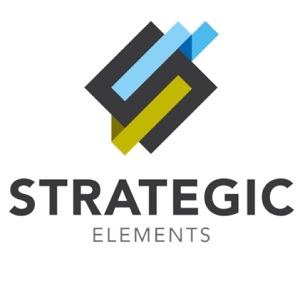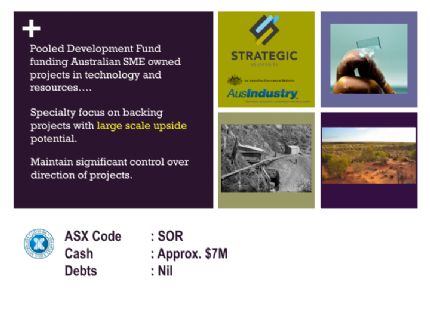 Newly Licenced Combined Transistor Memory Technology
Newly Licenced Combined Transistor Memory Technology
Sydney, Aug 27, 2015 AEST (ABN Newswire) - Strategic Elements ( ASX:SOR) is pleased to provide an update on its newly licenced UV light transistor-memory combination technology (UVTM). This innovative technology enables a transistor to also have non-volatile memory capacity.
ASX:SOR) is pleased to provide an update on its newly licenced UV light transistor-memory combination technology (UVTM). This innovative technology enables a transistor to also have non-volatile memory capacity.
The UVTM technology also has potential to be involved in encoding, storing and transmitting data using UV light. Many observers believe light controllable transistors may play an important role in next generation computing.
Transistors Background
In computing, transistors are used as electronic switches to turn electronic logic circuits on and off in response to tiny electrical signals. They form the basic building blocks of computer chips from processors and memory to controllers for graphics, network devices and even USB devices. Current processors contain up to 7 trillion transistors in an approximately 2cm2 single chip while memory chip transistor counts can be much higher.
Technology Highlights Although transistors in the market today have the capacity to also act as a memory device, it is a type of memory that cannot remember the information if the power is turned off. Hence, data processing and signal amplifying are the main functions of transistors. However, the UVTM technology is potentially capable of functioning as a combined transistor and non-volatile RRAM memory device (that can remember data when power and/or UV light is turned off).
The transistor function is capable of being dual-controlled by electronic voltages or UV light. Conventional transistors are only controlled by electronic voltages, and can produce significantly more heat.
Using UV light can dramatically reduce the heat generated by the transistor. The capacity to increase the number of transistors in a device is critical to increasing storage size in memory devices and processing power in computer chips.
With the reduced power usage of a UV light formed transistor, computer chips can be made smaller and denser without the effects of heat dissipation that cause problems to the overall function of the chip circuits.
More transistors means more powerful circuits and higher density memories within the same area as compared to conventional transistors that are used to create computer chips such as CPUs, controllers and memory.
The UVTM technology has the potential to be effectively utilised in many applications as a conventional transistor in CPUs, logic controllers for hard drives, graphics and display drivers as well as network routers and other computer chips.
The memory function is a RRAM and is non-volatile. This means the UVTM technology enables the device to remember information stored when the electrical power and/or UV light is switched off. The memory function can also be controlled by UV light. Prototype testing on the memory function has shown 10 times increase in storage and processing speeds and 20% less power consumption.
Other promising applications of the UVTM technology are related to its non-contact approach to data encoding by using UV light during the writing process, and can be involved in the storage and transport of secured information. With additional development, the technology has potential to be involved in not only storing data, but also the transmission of data to devices or locations using the UV light spectrum.
Company Comment
Managing Director, Charles Murphy said, "We licensed the technology for two main reasons. The first reason is that a transistor that also has the capacity for high performance non-volatile memory is facing into a significant global opportunity. The future potential to receive, store and transmit data to other devices or locations using UV light is something else all together. We are still developing the technology and are only starting to understand the potential impact it may have."
"The second reason is that the School of Materials Science and Engineering at UNSW is ranked number 1 in Australia, and the same team we are working with on the nanocube technology are also behind the UVTM technology. We have a good working relationship with them and they are doing some incredible work in their laboratories."
Memory Function of the UVTM The divergence of the two requirements of increasing performance while lowering power has posed a huge challenge for future memory system designers, as the limitations of existing widespread memory technologies is becoming increasingly apparent.
Exposing the transistors to UV light has been demonstrated in a laboratory prototype to open additional 'levels' for storage of information within the transistor's memory. This occurs as the UV light alters the properties of the transistor material to allow more information to be stored in each cell.
Importantly, this means that more information can be stored inside each transistor as there are more states available for the transistor to be set to, allowing multi-bit memory cells. Storing more information in each memory cell also increases the amount of memory than can be stored within the same chip size when compared to conventional memory.
UVTM - Memory Function Testing A prototype was fabricated in the UNSW laboratory to test the performance and power consumption of the UVTM technology. A prototype device was built containing non-volatile resistive memory that can be controlled electronically or by UV light.
(1) The prototype is a totally new method of utilising UV light to control the operations of a specially formulated metal-oxide semiconductor resistive switching memory.
(2) It is relatively simple to fabricate, consisting of only a few layers. The device responds to the application of UV light to change its properties and allows the modification of data being stored in the device. When UV light is switched off, the device retains its enhanced properties.
(3) Applying UV light to the specially formulated layered metal-oxide prototype device resulted in a 10 times increase in data storage and processing speeds.
(4) Power consumption during the operation was reduced greatly by 20% with the aid of non-contact UV light. The UV light does not generate any heat over the circuits.
(5) The prototype operations were at low voltage, thus, providing potential to overcome the existing reliability and overheating issues caused by electrical currents that prevents increasing the density using conventional transistors in most existing memory devices and computer chips.
(6) Furthermore, the prototype under UV light responded much faster in terms of data writing and erasing, as compared to its operation under normal conditions.
(7) Importantly, when the UV light is switched off, the device retains its enhanced properties.
Potential Storage and Transmission of Information
The application of UV light can be used to control the flow of current through the transistor. As the transistor is also a memory device, being able to store information in the transistor opens up the possibility of secure contactless communication of information via the medium of UV light.
Ultraviolet light (UV) light is invisible to the human eye, and is potentially difficult to detect without appropriate sensors. Therefore, this may be a good medium to facilitate secured data transmission.
Tuning the properties of the UV light can also control the function of the transistor. These properties can include power density and the wavelength of the UV light. This allows a contactless method to control the transistor and encode, or transmit data to devices using the transistor.
There is also the ultimate potential for these transistors to be embedded into devices such as smartphones to allow mobile secure transfer and data communications via the ultraviolet light spectrum.
Peer Reviewed Scientific Paper A scientific, peer reviewed paper written on some aspects of the technology will be published in 'Scientific Reports', a renowned and prestigious scientific journal. Scientific Reports publishes original articles on the basis that they are technically sound and scientifically valid, and papers are rigorously peer reviewed on these criteria prior to acceptance for publishing.
The Company is pleased some aspects of the technology will be covered in such an esteemed publication, and will inform the market when this is available.
Parties Behind The Technology
100% owned Australian Advanced Materials (AAM) has an exclusive global license for the technology from UNSW, and contracted the materials group at the UNSW School of Materials Science and Engineering to assist in development of a memory device prototype, make improvements to the nanocube memory technology and create new intellectual property.
The UNSW School of Materials Science and Engineering is ranked number 1 in Australia and number 26 in the world. The research group has received $20M in research grants since 2005, 45 researchers and $8M of world-class research equipment geared towards advanced materials.
About Strategic Elements Ltd
 Strategic Elements (ASX:SOR) shares are listed on the Australian Stock Exchange under the code “SOR”. The Company is registered under the Pooled Development Program run by the Australian Federal Government to encourage investment into SME’s. To assist Pooled Development Fund’s to invest and raise capital, the Federal Government enables most shareholders in a Pooled Development Fund to make capital gains and receive dividends tax-free.
Strategic Elements (ASX:SOR) shares are listed on the Australian Stock Exchange under the code “SOR”. The Company is registered under the Pooled Development Program run by the Australian Federal Government to encourage investment into SME’s. To assist Pooled Development Fund’s to invest and raise capital, the Federal Government enables most shareholders in a Pooled Development Fund to make capital gains and receive dividends tax-free.
![abnnewswire.com]()
Related Companies
Social Media
Share this Article

 ASX:SOR) is pleased to provide an update on its newly licenced UV light transistor-memory combination technology (UVTM). This innovative technology enables a transistor to also have non-volatile memory capacity.
ASX:SOR) is pleased to provide an update on its newly licenced UV light transistor-memory combination technology (UVTM). This innovative technology enables a transistor to also have non-volatile memory capacity. Strategic Elements (ASX:SOR) shares are listed on the Australian Stock Exchange under the code “SOR”. The Company is registered under the Pooled Development Program run by the Australian Federal Government to encourage investment into SME’s. To assist Pooled Development Fund’s to invest and raise capital, the Federal Government enables most shareholders in a Pooled Development Fund to make capital gains and receive dividends tax-free.
Strategic Elements (ASX:SOR) shares are listed on the Australian Stock Exchange under the code “SOR”. The Company is registered under the Pooled Development Program run by the Australian Federal Government to encourage investment into SME’s. To assist Pooled Development Fund’s to invest and raise capital, the Federal Government enables most shareholders in a Pooled Development Fund to make capital gains and receive dividends tax-free.




